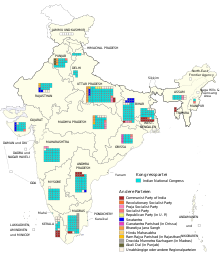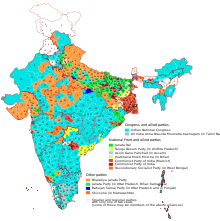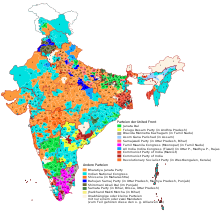
A | B | C | D | E | F | G | H | CH | I | J | K | L | M | N | O | P | Q | R | S | T | U | V | W | X | Y | Z | 0 | 1 | 2 | 3 | 4 | 5 | 6 | 7 | 8 | 9
| This article is part of a series on the |
| Politics of India |
|---|
 |
|
|
India has a parliamentary system as defined by its constitution, with power distributed between the union government and the states. India's democracy is the largest democracy in the world.[1]
The President of India is the ceremonial head of state of the country and supreme commander-in-chief for all defense forces in India. However, it is the Prime Minister of India, who is the leader of the party or political alliance having a majority in the national elections to the Lok Sabha (Lower house of the Parliament). The Prime Minister is the leader of the legislative branch of the Government of India. The Prime Minister is the chief adviser to the President of India and the head of the Union Council of Ministers.
India is regionally divided into States (and Union Territories) and each State has a Governor who is the state's head, but the executive authority rests with the Chief Minister who is the leader of the party or political alliance that has won a majority in the regional elections otherwise known as State Assembly Elections that exercises executive powers in that State. The respective State's Chief Minister has executive powers within the State and works jointly with the Prime Minister of India or their ministers on matters that require both State and Central attention. Some Union Territories also elect an Assembly and have a territorial government and other (mainly smaller) Union Territories are governed by an administrator/lieutenant governor appointed by the President of India.
The President of India monitors the rule of law through their appointed governors in each State and on their recommendation can take over the executive powers from the Chief Minister of the State, temporarily when the elected representatives of the State government have failed to create a peaceful environment and has deteriorated into chaos. The President of India dissolves the existing State government if necessary, and a new election is conducted.
Elections
Election Commission of India
The Election Commission of India (ECI) is an autonomous authority of India which is enacted under the provisions of the Constitution, responsible for monitoring and administering Union and State election processes in India. This body is responsible for ensuring elections are free and fair, without any bias.[2]
The ECI, established as a permanent Constitutional Body, is entrusted by the Constitution with the superintendence, direction, and control of the entire electoral process for Parliament, State Legislatures, and the offices of the President and Vice-President of India.
Election ensures the conduct of members pre-elections, during elections, and post-elections are as per the statutory legislation.
All election-related disputes are handled by the Election Commission. The Supreme Court of India has held that where the enacted laws are silent or make insufficient provisions to deal with a given situation in the conduct of elections, the Election Commission has the residuary powers under the Constitution to act as appropriate.The first chief election Commissioner was Sukumar Sen.
The elections for the President and Vice President of India, the Rajya Sabha (council of states) and Lok Sabha (house of the people), State Legislative Assemblies (including Union territories of Delhi and Puducherry), and State Legislative Councils are conducted by the Election Commission of India (ECI).
State Election Commissions
The State Election Commission (SEC) is an autonomous constitutional authority responsible for administering elections to the 3rd tier of governance i.e. the Local Government, which includes the Panchayati Raj Institutions and the Urban Local Bodies. As per the constitutional provision, 'superintendence, direction and control of the conduct of Elections to Urban & Rural Local bodies vest in State Election Commission.
State Election Commission consists of a State Election Commissioner, who is appointed by the Governor for a fixed tenure of 5 years and cannot be removed from his office except in like manner and on the like grounds as a Judge of a High Court.
The elections to local self-government institutions, such as panchayats and municipalities, are conducted by the respective State Election Commissions (SECs).[3]
Types of elections
Elections in the Republic of India include elections for
- President of India,
- Vice President of India,
- Members of the Parliament in Rajya Sabha (Upper house) and Lok Sabha (Lower house),
- Members of State Legislative Councils,
- Members of State Legislative Assemblies (includes legislative assemblies of three union territories - Jammu and Kashmir, National Capital Territory of Delhi and Puducherry)
- Members of local governance bodies (Municipal bodies and Panchayats),
- By-election is held when a seat-holder of a particular constituent dies, resigns, or is disqualified.
Parliamentary general elections (Lok Sabha)
Members of Lok Sabha (House of the People) or the lower house of India's Parliament are elected by being voted upon by all adult citizens of India, who crossed 18 years from a set of candidates who stand in their respective constituencies. Every adult citizen of India can vote only in their constituency. Candidates who win the Lok Sabha elections are called 'Member of Parliament' and hold their seats for five years or until the body is dissolved by the President on the advice of the council of ministers. The house meets in the Lok Sabha Chambers of the Sansad Bhavan in New Delhi, on matters relating to the creation of new laws, removing or improving the existing laws that affect all citizens of India. Elections take place once in 5 years to elect 543 members for the Lok Sabha (Lower house).[4]
 |
 |
 |
 |
 |
 |
 |
 |
 |
 |
 |
 |
 |
 |
 |
 |
 |










